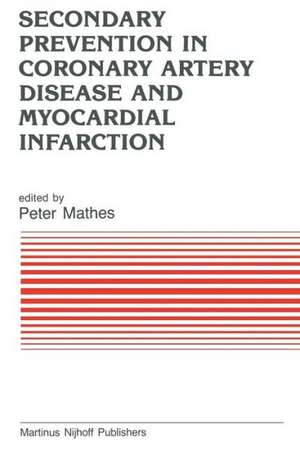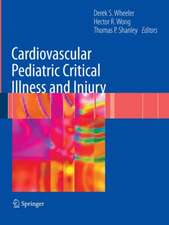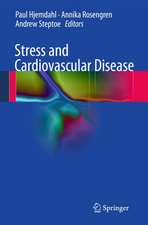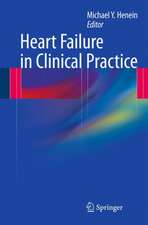Secondary Prevention in Coronary Artery Disease and Myocardial Infarction: Developments in Cardiovascular Medicine, cartea 48
Editat de P. Mathesen Limba Engleză Paperback – 8 oct 2011
Din seria Developments in Cardiovascular Medicine
- 5%
 Preț: 1484.50 lei
Preț: 1484.50 lei - 5%
 Preț: 375.17 lei
Preț: 375.17 lei - 5%
 Preț: 354.10 lei
Preț: 354.10 lei - 5%
 Preț: 1419.03 lei
Preț: 1419.03 lei - 5%
 Preț: 376.43 lei
Preț: 376.43 lei - 5%
 Preț: 1098.27 lei
Preț: 1098.27 lei - 5%
 Preț: 1438.38 lei
Preț: 1438.38 lei - 5%
 Preț: 376.78 lei
Preț: 376.78 lei - 5%
 Preț: 368.37 lei
Preț: 368.37 lei - 5%
 Preț: 380.25 lei
Preț: 380.25 lei - 5%
 Preț: 2117.58 lei
Preț: 2117.58 lei - 5%
 Preț: 367.28 lei
Preț: 367.28 lei - 5%
 Preț: 366.56 lei
Preț: 366.56 lei - 5%
 Preț: 371.10 lei
Preț: 371.10 lei - 5%
 Preț: 370.94 lei
Preț: 370.94 lei - 5%
 Preț: 783.18 lei
Preț: 783.18 lei - 5%
 Preț: 713.18 lei
Preț: 713.18 lei - 5%
 Preț: 1098.27 lei
Preț: 1098.27 lei - 5%
 Preț: 375.49 lei
Preț: 375.49 lei - 5%
 Preț: 373.47 lei
Preț: 373.47 lei - 5%
 Preț: 723.93 lei
Preț: 723.93 lei - 5%
 Preț: 1104.13 lei
Preț: 1104.13 lei - 5%
 Preț: 2117.20 lei
Preț: 2117.20 lei - 5%
 Preț: 716.09 lei
Preț: 716.09 lei - 5%
 Preț: 372.03 lei
Preț: 372.03 lei - 5%
 Preț: 722.33 lei
Preț: 722.33 lei - 5%
 Preț: 660.07 lei
Preț: 660.07 lei - 5%
 Preț: 375.34 lei
Preț: 375.34 lei - 5%
 Preț: 1423.22 lei
Preț: 1423.22 lei - 5%
 Preț: 715.35 lei
Preț: 715.35 lei - 5%
 Preț: 790.69 lei
Preț: 790.69 lei - 5%
 Preț: 720.68 lei
Preț: 720.68 lei - 5%
 Preț: 3185.49 lei
Preț: 3185.49 lei - 5%
 Preț: 1418.27 lei
Preț: 1418.27 lei - 5%
 Preț: 784.64 lei
Preț: 784.64 lei - 5%
 Preț: 714.63 lei
Preț: 714.63 lei - 5%
 Preț: 370.74 lei
Preț: 370.74 lei - 5%
 Preț: 376.22 lei
Preț: 376.22 lei - 5%
 Preț: 660.85 lei
Preț: 660.85 lei - 5%
 Preț: 368.37 lei
Preț: 368.37 lei
Preț: 372.38 lei
Preț vechi: 391.99 lei
-5% Nou
Puncte Express: 559
Preț estimativ în valută:
71.25€ • 74.39$ • 58.97£
71.25€ • 74.39$ • 58.97£
Carte tipărită la comandă
Livrare economică 04-18 aprilie
Preluare comenzi: 021 569.72.76
Specificații
ISBN-13: 9789401087254
ISBN-10: 9401087253
Pagini: 364
Ilustrații: 420 p.
Dimensiuni: 155 x 235 x 19 mm
Greutate: 0.51 kg
Ediția:Softcover reprint of the original 1st ed. 1985
Editura: SPRINGER NETHERLANDS
Colecția Springer
Seria Developments in Cardiovascular Medicine
Locul publicării:Dordrecht, Netherlands
ISBN-10: 9401087253
Pagini: 364
Ilustrații: 420 p.
Dimensiuni: 155 x 235 x 19 mm
Greutate: 0.51 kg
Ediția:Softcover reprint of the original 1st ed. 1985
Editura: SPRINGER NETHERLANDS
Colecția Springer
Seria Developments in Cardiovascular Medicine
Locul publicării:Dordrecht, Netherlands
Public țintă
ResearchCuprins
One: The Role of Risk Factors in Secondary Prevention.- 1. Cessation of Smoking.- 2. The Importance of the Cessation of Cigarette Smoking in the Tertiary Prevention of Coronary Heart Disease.- 3. Control of Hypertension.- 4. Lipid Lowering Regimens in Secondary Prevention of Coronary Heart Disease.- Two: The Role of Social Class in Secondary Prevention.- 5. Mortality after Myocardial Infarction. Role of Social and Behavioral Factors.- 6. The Impact of Social Level on Prognosis after Myocardial Infarction.- 7. Social Class and Prognosis in Coronary Heart Disease.- 8. Short and Long-term Prognosis After First Myocardial Infarction. Influences of Social Class.- Three: The Role of Medication in Secondary Prevention.- 9. Beta-blocking Agents in Secondary Prevention.- 10. Beta-Blocking Agents in Secondary Prevention After Acute Myocardial Infarction with Special Reference to the European Infarct Study (EIS).- 11. Platelet Aggregation Inhibitors.- 12. Platelet Inhibitors or Anticoagulants for Prevention of Aorto-coronary Bypass Graft Occlusion.- 13. Cardiovascular Protection by Calcium Antagonists.- 14. The Influence of Nitrates on Prognosis in Patients with Coronary Heart Disease.- 15. Metabolic Aspects of Preventive Drug Administration.- Four: The Role of Physical Exercise in Secondary Prevention.- 16. The Role of Physical Exercise in Secondary Prevention. Evidence to Date.- 17. The Behavior of the Ejection Fraction at Rest and Exercise in Myocardial Infarction Before and After a 4-week Training Period. Comparison to a Control Group.- 18. Adaptations to Prolonged Intense Exercise Training in Ischemic Heart Disease.- 19. Physical Activity and Sudden Death.- 20. Physical Exercise and Sympathetic Drive.- 21. Physical Exercise in Comprehensive Care.- 22. Exercise Capacity and Regional Myocardial Perfusion Distribution in Ischemic Heart Disease with and without Collateral Vessels.- Five: The Role of Psychosocial Factors in Secondary Prevention.- 23. Alteration of Type A Behavior and its Effect Upon the Cardiac Recurrence Rate in Post-myocardial Infarction Patients.- 24. A 5-year Controlled Clinical Trial on Psychological Well-being.- 25. Psychosomatic Aspects in Secondary Prevention.- 26. Social Isolation and Attitudes Towards Stress. A Behavioral Trap for Patients After Myocardial Infarction.- Six: The Role of Reperfusion in Secondary Prevention.- 27. Effect of Percutaneous Transluminal Coronary Angioplasty.- 28. Single Vessel Stenosis After Acute Myocardial Infarction: Which Patients Should Undergo Percutaneous Transluminal Coronary Angioplasty?.- 29. The Role of Coronary Bypass Surgery in Rehabilitation.- 30. Social Fate after Aorto-coronary Bypass Surgery.- 31. Clinical and Occupational Status of Patients with Coronary Artery Disease After Surgical Reperfusion.- 32. Which Factors do Influence the Rate of Employment After Surgical and Medical Treatment in Patients with Coronary Heart Disease?.- 33. Late Results of Reperfusion with Intracoronary Streptokinase.- 34. Percutaneous Transluminal Coronary Angioplasty After Thrombolysis to Prevent Reinfarction.
Recenzii
`...this book is a very interesting contribution to a major medical and socio-economical problem. This publication has clearly presented the multifacet aspects and difficulties of the subject.'
Acta Cardiologica (1986)
Acta Cardiologica (1986)












